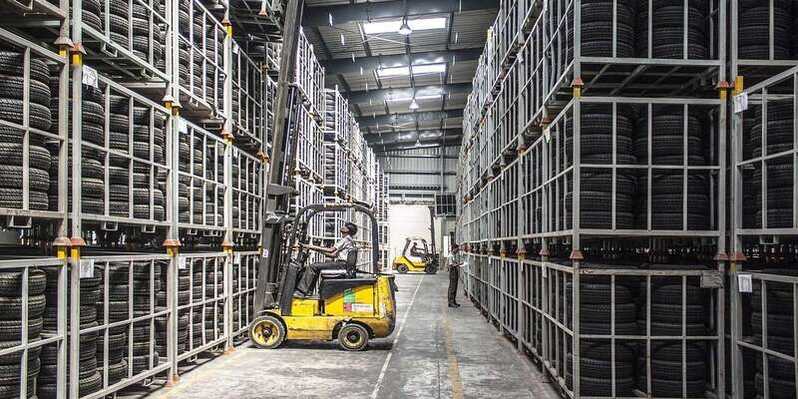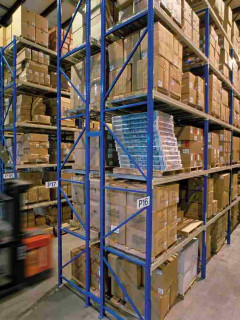Stacking pallets are a key element of your warehouse and supply chain and should be chosen carefully. There are a number of characteristics to consider, including the regulations governing the storage of wooden pallets and stacking height standards.There are also different pallet models to suit specific needs. Optimising your supply chain requires you to make well-informed choices,which is why we are offering you an overview of everything you need to know about stacking pallets.This article was updated in November 2020
- What is a stackable pallet?
- What are the regulations for stacking pallets?
- The different types of existing stackable pallets
- The right reflexes to optimise order picking
what is a stackable pallet?
Let’s take a look at the definition of a stackable pallet. These are pallets that can be stacked empty, or full. They allow you to optimise your storage space by placing several load units on top of each other, without having to use shelves.Logistical stacking can be suitable for any type of warehouse, and you have everything to gain from starting to use it to save space.
What are the regulations regarding pallet stacking?
If logistical stacking can be interesting for your warehouse strategy, it is still necessary to be aware of the regulations related to pallet stacking. As such, there are no regulations regarding pallet heights. However, the Occupational Health and Safety Regulation (S-2.1 r.13) stipulates that
- The stacking of materials must not interfere with the propagation of light (daylight or artificial light), the operation of machines and installations, access to electrical panels, traffic or stairs/lifts, or access to sprinkler systems or fire-fighting equipment.
- Workers should be provided with the necessary equipment to reach the top of stacks of equipment safely (step ladders, ladders, handholds, forklifts, etc.)
- Material should not be stacked at a height that compromises the stability of the stack
if you are inspected, the CSA A344.1-05 standard states that we will check if
- Goods protrude from the pallets
- Pallets are not smooth, damaged or not the right size
- Pallets have excessive loads
- Handling equipment is not secured
n’hésitez donc pas à former vos opérateurs aux meilleures pratiques de gerbage des palettes avant de vous lancer.

Les différents types de palettes gerbables existantes
Vous vous en doutez, il existe plusieurs types de palettes gerbables. Chacun ayant ses avantages et ses inconvénients.
La définition même des palettes gerbées suppose que vos produits seront stockés, et donc difficilement atteignables par un opérateur.
Il faudra ainsi veiller à intégrer le gerbage et sa manutention dans votre chaîne logistique en toute connaissance de cause.
Si, à présent, la définition du gerbage de palettes vous paraît assez éloignée d’une logique de productivité et de continuité de la chaîne logistique, vous allez voir que des solutions existent pour faciliter le travail de vos opérateurs, à tous les niveaux.
Quelle matière pour mes palettes ?
Si nous allons aborder ici les palettes gerbables dans leur ensemble, il est important de
revenir
su
- 9 out of 1 empty ;
- 3 out of 1 full;
- Load capacity: 1,000 kg.
stackable metal pallets
Designed specifically for bagged products, the stackable metal pallet offers you a solution for storing products that allows you to optimise your space. The products are placed at the bottom of the pallet on a wooden floor, and on removable metal crosspieces on the upper parts. The stacking height of these pallets makes them a solution to be favoured for the storage of high products such as
- Statues ;
- Musical instruments;
- Furniture;
- Large electronic parts.
the removable sides and the empty stacking pallets save space both when in use and when not. For a maximum load of 700 kg, the stacking capacity is
- Unladen: 9 to 1;
- Full: 2 to 1.

Les palettes gerbables pour picking
Voilà une solution à privilégier pour faciliter la tâche à vos préparateurs de commande.
Grâce à des palettes conçues pour le picking, vous apportez une souplesse d’exploitation dans l’espace alloué à la préparation de commandes.
Les bons réflexes pour optimiser ses préparations de commandes
L’optimisation du traitement des commandes, et a fortiori de la partie dédiée à la préparation des commandes, est un travail de longue haleine. Mais des améliorations significatives peuvent se faire en s’équipant des bons outils !
Il faut garder en tête que le gain de temps lors d’une préparation de commande s’obtient lorsqu’un espace est bien optimisé, et que le flux n’est pas interrompu.
Pour ce faire, on opte pour des convoyeurs à rouleaux, qui permettent une meilleure circulation des produits.
La mise en place d’une nouvelle organisation de l’entrepôt — plus logique — est également à préconiser
| The RAJA tip: the pallet box The pallet box can be an alternative solution. It is particularly used in export markets. It is a large, robust box that is mounted directly on a fixed pallet. |
the stackable height of the pallets can be adapted to your warehouses for even more flexibility. For each use its own pallet. But beyond the choice of the type of material used in its design, it is important to be informed about the advantages of stacking. Not only useful to optimise space in your warehouses, stackable pallets can also facilitate the work of your order pickers and prevent load interruptions in your logistics chain. Finally, don’t forget to find out about the regulations concerning the stacking of pallets and to follow the recommendations in terms of authorised stacking heights to the letter
Three key points to remember about stackable pallets
- Stacking pallets allow for optimised storage by stacking,
- Stacking in logistics is subject to regulations that you must respect,
- Using stacking in handling improves circulation in warehouses and increases productivity.
















